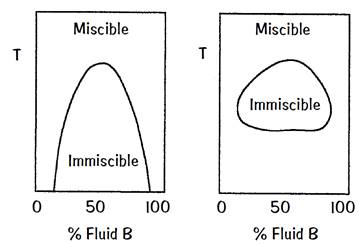
Binary Fluids
 المؤلف:
Franklin Potter and Christopher Jargodzki
المؤلف:
Franklin Potter and Christopher Jargodzki
 المصدر:
Mad about Modern Physics
المصدر:
Mad about Modern Physics
 الجزء والصفحة:
p 52
الجزء والصفحة:
p 52
 18-10-2016
18-10-2016
 738
738
Binary Fluids
The two possible phase diagrams show the miscible and immiscible phases of a binary fluid, a mixture of two

kinds of fluid, in a plot with axes of temperature versus concentration. For example, coffee and cream are miscible at room temperature but oil and water are not.
Consider the 50 percent mixture in each phase diagram and start at a high temperature in the miscible phase. The diagram to the left reveals that the binary fluids become immiscible upon being cooled, while the diagram to the right tells us that the fluids become immiscible as the cooling proceeds but that even further cooling brings back the miscible phase. Can both phase diagrams represent a real binary fluid, or is one false?
Answer
Both phase diagrams can represent actual binary fluids, although the diagram to the right is quite rare. To understand these phase diagrams, both energy and entropy must be considered. The energy part involves the van der Waals interaction between adjacent molecules, an induced dipole-dipole electromagnetic interaction. In general, this attractive force between unlike molecules is much weaker than the attractive force between like molecules. The stronger the force of attraction holding the molecules together, the lower the energy of the system. Hence, when most of the molecule’s neighbors are of the same chemical species, the system energy is lowest and immiscibility is favored. Even the increased random tumbling about of the molecules at higher temperatures doesn’t disrupt this clustering of like molecules.
However, energy considerations alone do not explain the behavior of binary liquids. Why are they miscible at all? The miscibility occurs at lower temperatures because the system tends to minimize not its energy but rather its free energy, Efree = Esys – TS. The free energy is the energy of the system minus the product of the temperature T and the system’s entropy S. At a given T, the free energy can be decreased by decreasing the system’s energy or by increasing its entropy. At low T, changing the entropy has a minimal effect because the product TS may be small. But at high T, the product can be large. So systems at high T tend to maximize their entropy, that is, their randomness or disorder.
We now have a good argument for ruling out the diagram to the right, with its reappearing miscible phase at low temperatures. Not so! For some molecules, hydrogen bonding occurs with its very small angular spread, locking two molecules together. This hydrogen bonding occurs primarily at lower temperatures because of the orientation dependence, with “orientation” entropy lost in forming the hydrogen bond being greater than the “compositional” entropy gained. Therefore both energy and entropy are lowered, and the lowered energy of the hydrogen bond has a large effect on the free energy. Water and butyl alcohol is one example of a binary liquid with the rare phase diagram.
 الاكثر قراءة في طرائف الفيزياء
الاكثر قراءة في طرائف الفيزياء
 اخر الاخبار
اخر الاخبار
اخبار العتبة العباسية المقدسة


